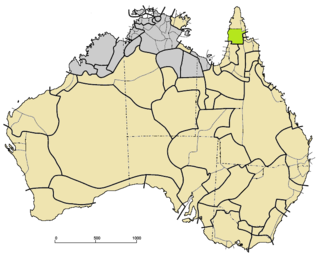Related Research Articles

The Shire of Aurukun is a local government area in Far North Queensland, Australia. The shire covers part of western Cape York Peninsula, the most northerly section of the Australian mainland.

The Wik languages are a subdivision of the Paman languages consisting of sixteen languages, all spoken on the Cape York Peninsula of Queensland, Australia. This grouping was first proposed by R. M. W. Dixon.
Wik-Ngatharr, or Wik-Alken (Wik-Elken), is a Paman language spoken on the Cape York Peninsula of Queensland, Australia, by the Wik-Ngatharr people. It is a co-dialect with Wik-Ngathan, and more distantly related to the other Wik languages. In 1981 there were 86 speakers.
The Wik peoples are an Indigenous Australian group of people from an extensive zone on western Cape York Peninsula in northern Queensland, speaking several different languages. They are from the coastal flood plains bounding the Gulf of Carpentaria lying between Pormpuraaw and Weipa, and inland the forested country drained by the Archer, Kendall and Holroyd rivers. The first ethnographic study of the Wik people was undertaken by the Queensland born anthropologist Ursula McConnel. Her fieldwork focused on groups gathered into the Archer River Mission at what is now known as Aurukun.
Wik-Mungkan, or Wik-Mungknh, is a Paman language spoken on the northern part of Cape York Peninsula of Queensland, Australia, by around 1,000 Wik-Mungkan people, and related peoples including the Wikalkan, Wik-Ngathana, Wikngenchera language groups. Wik Mungkan is healthier than most other languages on the peninsula, and is developing and absorbing other Aboriginal languages very quickly.
Wik-Ngathan, or Wik-Iinjtjenj (Wik-Iinychanya), is a Paman language spoken on the Cape York Peninsula of Queensland, Australia, by the Wik-Ngathan people. It is closely related to the other Wik-Ngathan language, Wik-Ngatharr and more distantly to the other Wik languages. In 1981 there were 130 speakers.
Kugu-Muminh (Wik-Muminh), also known as Kugu- or Wik-Nganhcara (Wikngenchera), is a Paman language spoken on the Cape York Peninsula of Queensland, Australia, by several of the Wik peoples. There are multiple dialects, only two of which are still spoken: Kugu-Muminh itself, and Kugu-Uwanh.

The Paman languages are an Australian language family spoken on Cape York Peninsula, Queensland. First noted by Kenneth Hale, Paman is noteworthy for the profound phonological changes which have affected some of its descendants.
Wik-Me'nh is a Paman language of the Cape York Peninsula of Queensland, Australia
Wik Ompom (Ambama) is an extinct Paman language of the Cape York Peninsula of Queensland, Australia. Its name suggests it is one of the Wik languages, but typologically it is distinct.
The Kendall River is a river located in Far North Queensland, Australia.
The Ayapathu people, otherwise known as the Ayabadhu or Aiyaboto, were an Indigenous Australian group, living on the western side of the Cape York Peninsula in northern Queensland.
The Kugu Nganhcara, also Wikngenchera, Wik-Ngandjara (Ngandjara) are an Australian group of peoples living in the middle western part of the Cape York Peninsula, Queensland in Australia. Today they are primarily concentrated at Aurukan and the Edward river settlement.
The Wikianji were an indigenous Australian tribe of the Cape York Peninsula of northern Queensland.
The Wiknatanja were an indigenous Australian people, one of the Wik tribes of the Cape York Peninsula of northern Queensland.
The Wikmean were an indigenous Australian people, one of the Wik tribes of the Cape York Peninsula of northern Queensland.
The Wikepa are an indigenous Australian people, one of the Wik tribes of the Cape York Peninsula of northern Queensland.
The Wik Paach or Wikapatja were an indigenous Australian people of the Cape York Peninsula of northern Queensland.
The Wikatinda were an indigenous Australian people of the Cape York Peninsula of northern Queensland. They were one of the Wik peoples, but their language is unattested.
References
- 1 2 Y47 Wik Paach at the Australian Indigenous Languages Database, Australian Institute of Aboriginal and Torres Strait Islander Studies
- ↑ Peter Sutton, "Aboriginal Australia: social dialects", in Suzanne Romaine, ed., Language in Australia, CUP, 1990:60.